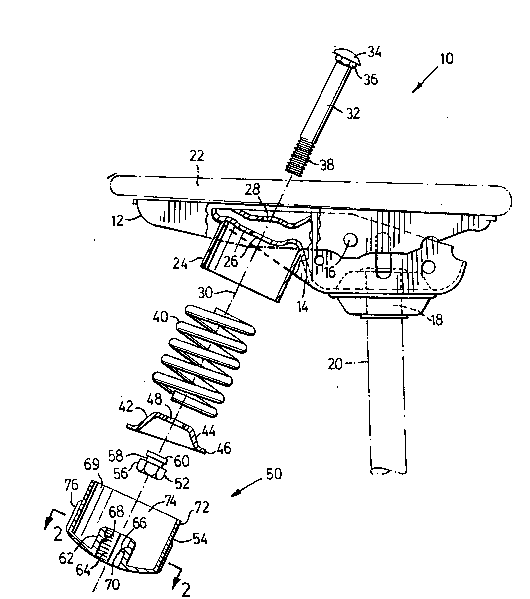Une partie des informations de ce site Web a été fournie par des sources externes. Le gouvernement du Canada n'assume aucune responsabilité concernant la précision, l'actualité ou la fiabilité des informations fournies par les sources externes. Les utilisateurs qui désirent employer cette information devraient consulter directement la source des informations. Le contenu fourni par les sources externes n'est pas assujetti aux exigences sur les langues officielles, la protection des renseignements personnels et l'accessibilité.
L'apparition de différences dans le texte et l'image des Revendications et de l'Abrégé dépend du moment auquel le document est publié. Les textes des Revendications et de l'Abrégé sont affichés :
| (12) Brevet: | (11) CA 2019521 |
|---|---|
| (54) Titre français: | LEVIER PERMETTANT LE REGLAGE DE LA CHAISE |
| (54) Titre anglais: | HANDLE ASSEMBLY FOR CHAIR CONTROL MECHANISM |
| Statut: | Périmé et au-delà du délai pour l’annulation |
| (51) Classification internationale des brevets (CIB): |
|
|---|---|
| (72) Inventeurs : |
|
| (73) Titulaires : |
|
| (71) Demandeurs : |
|
| (74) Agent: | SMART & BIGGAR LP |
| (74) Co-agent: | |
| (45) Délivré: | 1994-11-15 |
| (22) Date de dépôt: | 1990-06-21 |
| (41) Mise à la disponibilité du public: | 1991-12-21 |
| Requête d'examen: | 1992-11-20 |
| Licence disponible: | S.O. |
| Cédé au domaine public: | S.O. |
| (25) Langue des documents déposés: | Anglais |
| Traité de coopération en matière de brevets (PCT): | Non |
|---|
| (30) Données de priorité de la demande: | S.O. |
|---|
A chair control mechanism of the type having a seat
support member pivotally mounted on a leg mounting member, and a
spring loaded adjustment mechanism for controlling the pivotal
movement of one member with respect to the other. The adjustment
mechanism includes a handle mounted on an adjustment screw for
movement therealong to compress or allow extension of the
compression spring. A nut is threadedly mounted on the
adjustment screw and serves to retain the members, adjustment
screw and spring in an assembled configuration during shipping to
and assembly of a chair by a chair manufacturer. A hand wheel is
provided for attachment to the nut after the control mechanism
has been assembled and installed in a chair. The hand wheel has
a body of plastics material in which a seat formed which is
proportioned to accommodate and adapted to cooperate with the nut
such that when the nut is seated therein, rotation of the hand
wheel will cause rotation of the nut with respect to the
adjustment screw. The seat also cooperates with the nut to
prevent removal of the nut therefrom. The body of plastics
material is sufficiently flexible to permit resilient deformation
of the seat to admit the nut thereto.
Note : Les revendications sont présentées dans la langue officielle dans laquelle elles ont été soumises.
Note : Les descriptions sont présentées dans la langue officielle dans laquelle elles ont été soumises.

2024-08-01 : Dans le cadre de la transition vers les Brevets de nouvelle génération (BNG), la base de données sur les brevets canadiens (BDBC) contient désormais un Historique d'événement plus détaillé, qui reproduit le Journal des événements de notre nouvelle solution interne.
Veuillez noter que les événements débutant par « Inactive : » se réfèrent à des événements qui ne sont plus utilisés dans notre nouvelle solution interne.
Pour une meilleure compréhension de l'état de la demande ou brevet qui figure sur cette page, la rubrique Mise en garde , et les descriptions de Brevet , Historique d'événement , Taxes périodiques et Historique des paiements devraient être consultées.
| Description | Date |
|---|---|
| Inactive : CIB désactivée | 2019-01-19 |
| Inactive : CIB du SCB | 2018-01-27 |
| Inactive : CIB expirée | 2018-01-01 |
| Lettre envoyée | 2008-01-10 |
| Lettre envoyée | 2007-10-29 |
| Inactive : CIB de MCD | 2006-03-11 |
| Inactive : CIB de MCD | 2006-03-11 |
| Lettre envoyée | 2005-10-13 |
| Le délai pour l'annulation est expiré | 2003-06-23 |
| Lettre envoyée | 2002-06-21 |
| Lettre envoyée | 2002-05-01 |
| Inactive : Demande ad hoc documentée | 2002-04-30 |
| Inactive : Correspondance - Transfert | 2002-04-11 |
| Lettre envoyée | 2002-03-12 |
| Inactive : Lettre officielle | 2002-03-12 |
| Inactive : Lettre officielle | 2002-03-12 |
| Lettre envoyée | 2002-03-12 |
| Inactive : Transferts multiples | 2002-01-30 |
| Accordé par délivrance | 1994-11-15 |
| Toutes les exigences pour l'examen - jugée conforme | 1992-11-20 |
| Exigences pour une requête d'examen - jugée conforme | 1992-11-20 |
| Demande publiée (accessible au public) | 1991-12-21 |
Il n'y a pas d'historique d'abandonnement
| Type de taxes | Anniversaire | Échéance | Date payée |
|---|---|---|---|
| TM (brevet, 8e anniv.) - générale | 1998-06-22 | 1998-05-19 | |
| TM (brevet, 9e anniv.) - générale | 1999-06-21 | 1999-05-18 | |
| TM (brevet, 10e anniv.) - générale | 2000-06-21 | 2000-06-02 | |
| TM (brevet, 11e anniv.) - générale | 2001-06-21 | 2001-06-04 | |
| Enregistrement d'un document | 2002-01-30 |
Les titulaires actuels et antérieures au dossier sont affichés en ordre alphabétique.
| Titulaires actuels au dossier |
|---|
| LEGGETT & PLATT LTD. |
| Titulaires antérieures au dossier |
|---|
| WILLIAM S. STUMPF |